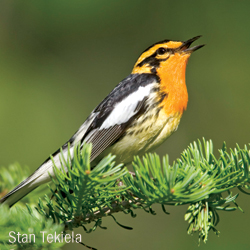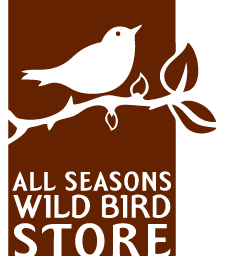Minnesota hosts several birds that sport orange and black coloration. Let’s take a closer look!

Baltimore Oriole
This eye-catching songbird (8-1/2 in / 22 cm) is a summer visitor throughout most of Minnesota, coming to feeding stations to dine on orange slices, grape jelly, nectar and mealworms. The male Baltimore Oriole has a black head and back with orange chest and belly. Its mostly black wings are touched with orange and have white wing bands. Females are a pale yellow-orange with grayish-black wings and white wing bars.

American Redstart
This warbler (4-3/4 in/12 cm) is a summer visitor and one of the few warbler species that stays to nest in the Twin Cities area. Look for them to arrive starting in May. Males have a black head and back, white belly and patches of orange at shoulders, wings and base of tail. Females are olive-gray with yellow accents under wings and at side of tail.
While American Redstarts do not visit feeders (they eat insects), they may come to visit birdbaths.

Blackburnian Warbler
Another warbler, this handsome bird (5 in/13 cm) passes through the Twin Cities area around the 10th of May en route to breeding areas in Northern Minnesota and Canada. The male is a black and white bird with bright orange on its head and throat and a black mask. The female has paler orange/yellowish coloring. You may seem them flitting along tops of conifers and deciduous trees in your yard, hunting for insects and larvae. They may also stop for a drink at birdbaths.

Eastern Towhee
This striking size-large sparrow with red eyes (8 in/21 cm), is widely seen in Minnesota during the summer in open woods, undergrowth and brush edges, and browsing in leaf litter beneath feeders for seeds and insects. Technically more rufous or rust-colored than orange, the male has a black hood, back and wings, white belly and rusty-orange sides. The female is similar with brown instead of dark black.

HONORARY ORANGE & BLACK:
American Robin
This widely common thrush (10 in/ 25 cm) deserves a mention for its color scheme of a dark gray back and bright rust-orange belly. Female coloration is a slightly duller version of the male. American Robins prefer to browse for insects and fruit, but may visit feeders for mealworms, and—infrequently—grape jelly. They love to visit backyard birdbaths. American Robins are becoming a more common sight year-round in Minnesota as birds follow availability of food sources.


